The summer heat of July has long since transformed the lush flower meadows in southern Armenia into golden steppe landscape. Fresh greenery can still be found almost only around housing estates, which are often located in river valleys. And the following two typical features that we would like to share with you 😉
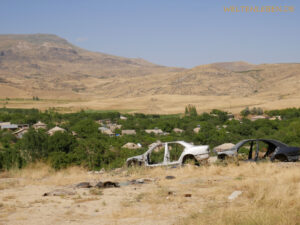
Sun-baked golden-brown steppe, green riverbanks…and old car skeletons that sometimes serve one, sometimes no obvious function. This is how it is more often found in Armenia 😉
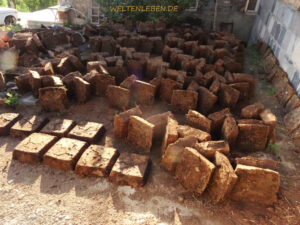
Dried cow dung in geometric shapes can be found everywhere. Surely it serves as fuel in this forest-poor country.
After the most southeastern point of our journey, the Tatev monastery, we head northwest for the first time. We will stay in this wonderful country for three weeks out of a total of exactly 2 months.
We head for the archaeological site of Zorats Karer, or as it is also called, Carahunge (poor.: “collection of stones”). This is a Bronze Age burial ground with remains of an ancient settlement. Particularly striking here are the approximately 223 towering rock colossi weighing several tonnes, some of which are arranged in a circle around a central burial chamber. Some of them have a man-made hole at the top, which may have been necessary to transport the stones to their planned site with ropes. However, there is also the theory that the stones with holes were aligned according to plan so that the site served as a prehistoric solar and lunar observation and thus (ge)timing site. Either way, it is once again exciting for us to move consciously on such old cultural terrain.
For a few impressions click on the gallery:
Then we head for one of Armenia’s official highlights. This is, as so often in this Christian country, an old monastery. Incidentally, it is said that Armenia was the very first complete country to profess Christianity!
The famous monastery Chor Virap dates back to the 17th century AD and is also famous for its location: within sight of the monastery is the 5,137m high Mount Ararat, sacred to the Armenians and also biblically significant, as Noah’s Ark is said to have been stranded here after the Flood. It is also considered the national symbol of Armenia. The sad irony of it all is that it has been on Turkish territory for quite some time, and thus, at the latest since the genocide of the Armenians by the Ottoman Empire in 1915, in “enemy territory”. In any case, the sight of the huge mountain is spectacular, on which there is still a fair amount of snow, even now in the middle of midsummer. And seen from a certain point on the drive to the monastery, the mountain is enthroned right behind it and forms the perfect backdrop.
We spend a night with a beautiful view in the area and pay a short visit to the monastery the next day. There is a lot of hustle and bustle here, with busloads of tourists arriving – we have never experienced this in Armenia before – and we realise once again that some sights are more impressive from a distance than up close 😉 A click opens the following gallery:
Immediately afterwards we are even allowed to enjoy Armenian hospitality again, and this in a very private setting. At the campsite of the previous evening, next to a few apricot trees, an elderly man approached us. As is often the case, we communicated with hands and feet. Unfortunately, we only have a few words of Russian, which every adult in the country seems to speak fluently in addition to Armenian. But his invitation to his home for a coffee is unmistakable. Wow – would we offer this ourselves to foreigners, tourists? Would you do it? This openness, warmth and generosity leaves us speechless, grateful and humble once again. We actually accept an invitation to the private home of a friendly person for the first time and, a little excited, follow his instructions to the door of his house and yard.
The door opens and his wife and three grandchildren, all boys in their teens, welcome us. The dwelling is simple by German standards, but it has everything it needs. There is even a flush toilet – in Georgia and Armenia an outhouse in the garden is still often seen in rural areas! A woman about Sophia’s age flits around a little shyly and soon serves cake and coffee. The maid…? Oh no, the daughter-in-law…. 😉 Here, as in the rest of the country, patriarchal family relations still prevail and this woman, as the youngest female member of the family, is clearly obliged to serve while her sons are allowed to make themselves comfortable.
We are allowed to be silent, to enjoy and to nod and marvel a lot – because a photo book is proudly placed on our laps with beautiful photographs of the surrounding countryside from the 80s/90s; even the master of the house can be seen as a young man in his profession as a shepherd! And even more proudly, the family album is presented to us and all the people in it are named and related. The youngest grandson, he is about 11 years old, even learns English at school and reads out the descriptions of German partner universities to applause. In short, these are hours full of personal insights into the lives of these, and possibly other, families in Armenia. And we finally say goodbye, grateful for this insight and the hospitality we have experienced, and take another very special memory with us.
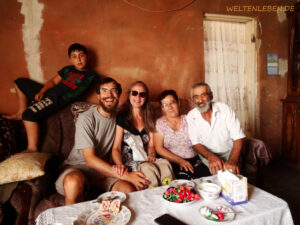
Thank you 🙂
Afterwards we drive a bit further to the capital Yerevan. However, the summer heat and unpleasant city encounters drive us out of the hustle and bustle again after just one night. After all the peace and nature we have enjoyed in the last few weeks, we don’t feel too comfortable here among more than 1 million people and in the middle of traffic and blocks of houses. Apart from some more or less magnificent buildings, and again the silhouette of the Ararat in the city background, there are also some new noses to marvel at – quite literally, apparently cosmetic surgery in this area is all the rage here and many young girls are walking around with large plasters on their new noses! 😉
Come with me to the city for a moment in this gallery:
Much more beautiful for us is the discovery of the “Symphony of Stones” and the “Temple of Garni” not too far away. The “Symphony of Stones” are a natural wonder, hundreds of columns close together, formed from basalt rock. Some of the layers have already broken off from the bottom to the top, so that some of the columns seem to float in the air. Countless swallows’ nests are diligently incubated here, protected from human hands by their altitude.
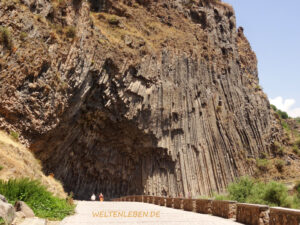
Thousands of stone pillars form visually attractive cave formations at various points.
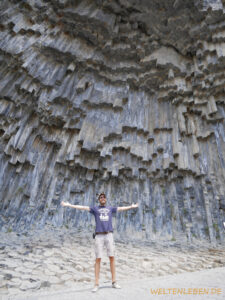
It’s magic! 🙂
The temple of Garni, on the other hand, is also well visited by tourists. Nevertheless, there are still quite quiet corners on the fairly large grounds, which we explore at leisure.
Come along with a click:
As we continue our journey north, we pick out a few more historical stops. You can find the two most exciting ones in the following gallery:


But our last Armenian highlight is once again nature itself, with a surprise factor: At a campsite in the middle of “nowhere” we have the enormous luck to observe more than 70 storks resting and flying on towards the south! From the middle of the country, the stork nests were already accumulating, in almost all of them there were offspring. And here too, at this spectacle, we can still distinguish the young birds with their slightly greyish plumage from the adults. For about 20 minutes we first watch them drinking and wading in one of the last pools in the area, then they fly off one by one and finally spiral into the air in a circle just above our heads until they finally fly away over the next hill. What a gift to be able to watch this!
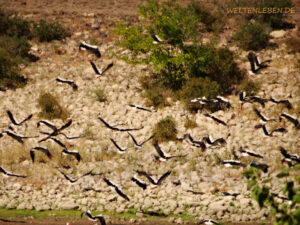
Take-off for some of the storks.
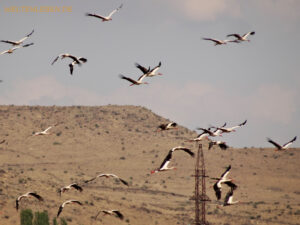
The wing beats carry ever higher – sometimes directly above our heads.
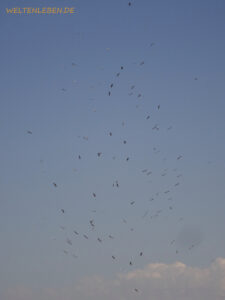
…until these majestically large animals are just small dots on the horizon.
We head for two last stops: First, the city of Gyumri, which is already the second largest city in Armenia with only about 180,000 inhabitants. The sights are quickly reached on foot and by bike and after a few culinary discoveries typical of the country and a night on site, we follow the call northwards again.
Click on the gallery for a small impression:
Finally, the last stop is Lake Arpi National Park. We already had this stop in mind when we entered the country at the beginning of June and now, pretty much at the beginning of August, we are here. While in Yerevan we were “only” about 1,000 metres above sea level, here we are again at 2,000 metres! And once again we are amazed to see huge poplars and other deciduous trees standing there in full size and providing us with shade. They obviously don’t know anything about the “tree line at 1,500 metres” in our home latitudes 😉 Here we find flower meadows again and butterflies and bees bring in their harvest. We stay here for a few days at two different campsites, enjoy the peace and quiet, let our impressions sink in and review our journey so far.
Click to open the gallery:
At the same time, we are gathering new strength and energy for the route back, which will be a kind of journey home, as we want to make a short stop back home before heading to our “winter quarters”: We are already looking forward to Morocco! 🙂
It took 11 months and almost 12,000 kilometres until we arrived in Armenia.
We want to make it back in just 2 months. Always along the Black Sea coast, first through Turkey – this alone is over 2,000 kilometres – then through Bulgaria and finally in a direct line to Bavaria. In total, there are 4,320 kilometres ahead of us. It will be a very intensive time and the subsequent home weeks will be in no way inferior.
With the joy of being able to continue the journey in our luggage, we finally arrive in Morocco in December! Get ready for a leap in time and country! We look forward to a literary reunion with you, dear reader, in Morocco! 🙂
Until then, have a safe journey – the worldly Chris and Sophia
P.S. Most of our contributions are now also available in English – for our travel acquaintances and also for your friends around the globe! 🙂 We are happy about every single visitor! For the English view, click on the following link: weltenleben.de/en/english/



























